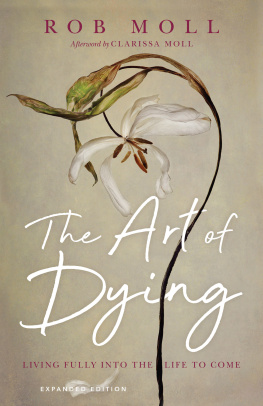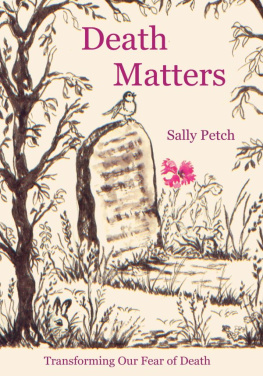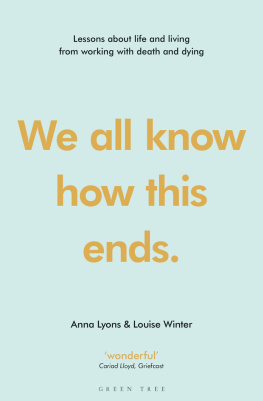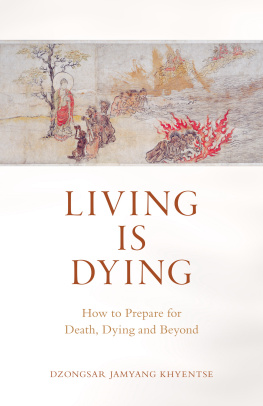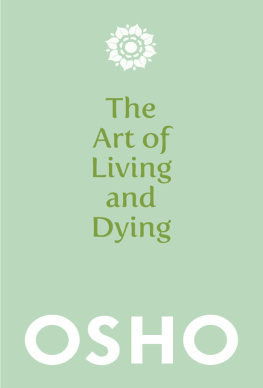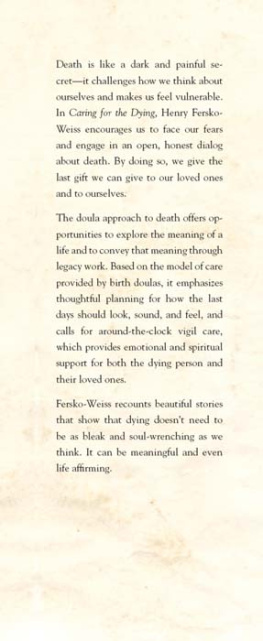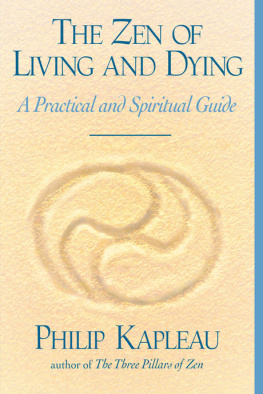Sommaire
Pagination de ldition papier
Guide
PRAISE FOR THE FIRST EDITION
This book is urgently needed by many churches and individuals who dont help their members or loved ones to die well. Rob Moll reminds Christians not to be afraid of their own deaths. His numerous ideas also teach us how to accompany other people to their deaths. I pray this book will enable many congregations to develop new practices and programs for the elderly and their caretakers.
Marva J. Dawn, author of Being Well When Were Ill, My Soul Waits and In the Beginning, GOD
Every seminarian and parish minister should read this book. Rob Moll recovers the Christian traditions lost teaching on preparing for death. He then offers theologically sound guidance for families and clergy as they serve the dying and then honor their legacy. Indispensable.
David Neff, editor in chief and vice president, Christianity Today Media Group
Dying has for many today, like sex in the nineteenth century, become the great unmentionable. But this brave, realistic, well-researched and well-digested book restores the good death, as the climax of faithful discipleship, to the Christian radar screen. On going home to God, and helping others on the same journey, what is said here is excellent from every point of view.
J. I. Packer, professor of theology, Regent College, and author of Knowing God
The Art of Dying takes the fear out of dying and replaces it with rich models of dying well. Drawn from a broad spectrum of historical, theological, bioethical, social and practical resources, interlaced with captivating narrative, The Art of Dying paints a vision of what dying and grieving with the Christian community has looked likeand once again should look like. While it is particularly relevant for every Christian who will die, other mortals will benefit from reading over our shoulders.
Paige Comstock Cunningham, J.D., executive director, The Center for Bioethics & Human Dignity
InterVarsity Press
P.O. Box 1400, Downers Grove, IL 60515-1426
ivpress.com
2010 by Rob Moll
Afterword 2021 by Clarissa Moll
All rights reserved. No part of this book may be reproduced in any form without written permission from InterVarsity Press.
InterVarsity Press is the book-publishing division of InterVarsity Christian Fellowship/USA, a movement of students and faculty active on campus at hundreds of universities, colleges, and schools of nursing in the United States of America, and a member movement of the International Fellowship of Evangelical Students. For information about local and regional activities, visit intervarsity.org.
All Scripture quotations, unless otherwise indicated, are taken from The Holy Bible, New International Version, NIV. Copyright 1973, 1978, 1984, 2011 by Biblica, Inc. Used by permission of Zondervan. All rights reserved worldwide. www.zondervan.com. The NIV and New International Version are trademarks registered in the United States Patent and Trademark Office by Biblica, Inc.
While any stories in this book are true, some names and identifying information may have been changed to protect the privacy of individuals.
The publisher cannot verify the accuracy or functionality of website URLs used in this book beyond the date of publication.
Cover design and image montage: Cindy Kiple
Image: dried tulip Photography by Polina Plotnikova / Moment Collection / Getty Images
ISBN 978-0-8308-4722-8 (digital)
ISBN 978-0-8308-4721-1 (print)
This digital document has been produced by Nord Compo.
To Clarissa and the kids
FOREWORD
Lauren Winner
O N A BOOKCASE IN MY OFFICE, I have a cup full of nineteenth-century rings: some feature skeletons, some hold locks of hair. These were mourning ringsrings that people wore in memory of dead parents, spouses, friends. The rings are engraved with the decedents initials, and sometimes with a death date. This was a commonplace practice in the eighteenth and nineteenth century, this exchanging of mourning rings. The rings helped the bereaved continue to feel close to their dead. And the rings kept the reality of death ever before people, intimately wrapped around their fingers.
Americans have largely given up mourning jewelry. Indeed, we have given up a whole host of embodied and communal practices of death that once shaped how Americans died and grieved.
If you had been, say, a middle-class white woman in the United States 175 years ago, an elaborate choreography of death and mourning would have been familiar to you. You would have passed countless hours at the deathbeds of friends and relatives who died at home. There, one of your tasks would have been to help the dying person realize that she was in fact dying. You were there, in part, to encourage your friend to make her peace with friends, relatives and God. You would have visited homes of bereaved neighbors and encountered corpses, laid out awaiting burial, in their parlors. You would have regularly walked among tombstonesin your churchyard, or perhaps even in your backyard. You would have been accustomed to meeting men and women in mourning garbblack armbands for men, dresses made of drab black fabric for women. Their mourning clothing would have told you, wordlessly, of their grief. You would probably have worn mourning clothing yourself at some point. Your bombazine or crepe gown would have helped you live into your mourningand the social convention telling you when to put the black dress away would have given you an important calendar, telling you when mourning was to end, telling you when to resume the rhythms of life fully among the living.
For Christians in most times and places, death has been a routine part of life. But during the last century, Americans have embraced an unprecedented denial of death, an unprecedented evasion of death. In general, we have removed death from our homes. People no longer die there; corpses no longer repose there before burial. We no longer allow people to say that they are dyingrather, they are battling an illness. Far from encouraging the perilously ill to recognize the imminence of their death, we encourage the sick (and their doctors) to fight deathbut not to prepare for it. Most of us live far from graveyards, which we now locate on the periphery of suburbs, not in our backyards, not in places we routinely encounter. And rather than acknowledge the long unfolding of mourning, we praise bereaved people for the speed with which they get back to normal after their husband or mother or friend dies.
Some would say this evasion of death is an improvement. Some would say my mourning rings are macabre. I would say our avoidance of death, far from being an advance, is false, costly and alienating. We, the church, need to recover the art of dying. We need to reacquaint ourselves with death. We need to help people die well and mourn well. We need to lament. We need to allow dying Christians to be just thatdying Christians, who can rail against, but also prepare for, death. We need to make space for the exhausting, sad work of mourning.
The history of dying that Rob Moll sketches here, and the practices of dying and mourning well that he describes, illustrate the rich resources we have for a recovered, reimagined art of dying. I hope that people will read this bookand talk about it, and take inspiration from it. I hope we will let Rob Molls insights help us become communities where people can reckon with, rather than dodge, death.

